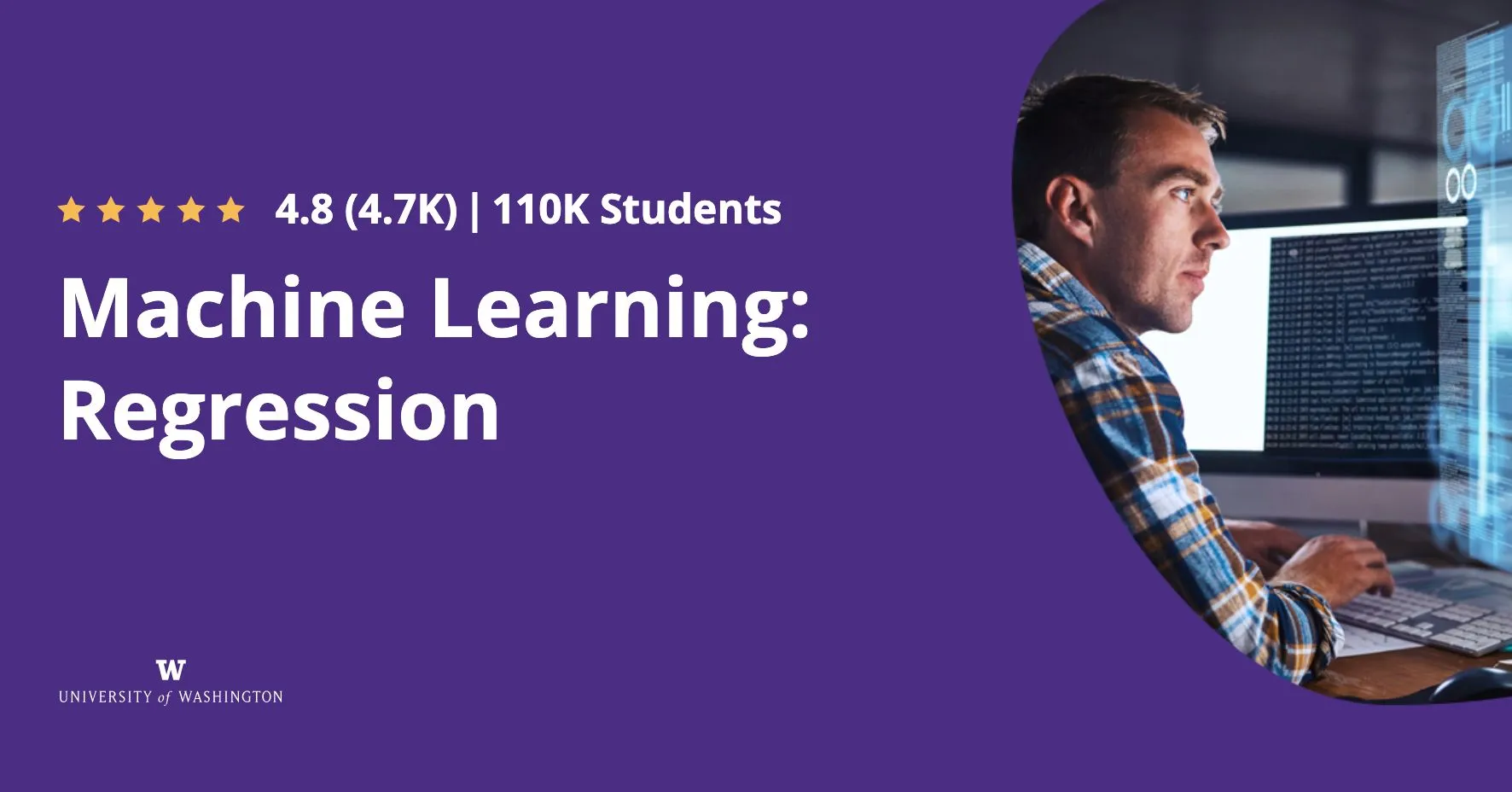
Machine Learning: Regression 
This case study explores the use of machine learning to predict housing prices based on square footage, number of bedrooms and bathrooms. Through regression analysis, models are developed to accurately estimate the value of a home. ▼
ADVERTISEMENT
Course Feature
![]() Cost:
Cost:
Free
![]() Provider:
Provider:
Coursera
![]() Certificate:
Certificate:
No Information
![]() Language:
Language:
English
![]() Start Date:
Start Date:
Self Paced
Course Overview
❗The content presented here is sourced directly from Coursera platform. For comprehensive course details, including enrollment information, simply click on the 'Go to class' link on our website.
Updated in [March 06th, 2023]
This course, Machine Learning: Regression, is designed to provide students with an introduction to the fundamentals of machine learning. The course will cover the basics of regression, including linear regression, logistic regression, and regularization. It will also cover more advanced topics such as tree-based methods, support vector machines, and neural networks.
The first half of the course will focus on the fundamentals of regression, including linear regression, logistic regression, and regularization. Students will learn how to use these methods to build predictive models and interpret the results.
The second half of the course will cover more advanced topics such as tree-based methods, support vector machines, and neural networks. Students will learn how to use these methods to build more complex models and interpret the results.
It is assumed that students have a basic understanding of statistics and programming. Knowledge of linear algebra and calculus is also recommended.
[Applications]
After completing this course, students should be able to apply the concepts of Machine Learning: Regression to their own projects. They should be able to identify the appropriate regression model for a given problem, understand the assumptions of the model, and interpret the results. Additionally, they should be able to use the techniques learned in the course to build and evaluate regression models.
[Career Paths]
1. Data Scientist: Data Scientists use machine learning algorithms to analyze large datasets and uncover patterns and insights. They use these insights to develop predictive models and create data-driven solutions. As the demand for data-driven solutions increases, the demand for Data Scientists is expected to grow.
2. Machine Learning Engineer: Machine Learning Engineers are responsible for developing and deploying machine learning models. They use a variety of programming languages and frameworks to build and deploy models, and they must be able to interpret and explain the results of their models. As machine learning becomes more widely used, the demand for Machine Learning Engineers is expected to increase.
3. Artificial Intelligence Engineer: Artificial Intelligence Engineers are responsible for developing and deploying AI-based solutions. They use a variety of programming languages and frameworks to build and deploy AI-based solutions, and they must be able to interpret and explain the results of their models. As AI becomes more widely used, the demand for Artificial Intelligence Engineers is expected to increase.
4. Business Intelligence Analyst: Business Intelligence Analysts use machine learning algorithms to analyze large datasets and uncover patterns and insights. They use these insights to develop predictive models and create data-driven solutions. As the demand for data-driven solutions increases, the demand for Business Intelligence Analysts is expected to grow.
[Education Paths]
1. Bachelor's Degree in Computer Science: A Bachelor's Degree in Computer Science provides a comprehensive foundation in the fundamentals of computer science, including programming, algorithms, data structures, and software engineering. It also covers topics such as machine learning, artificial intelligence, and data science. This degree is ideal for those interested in pursuing a career in machine learning and regression. With the increasing demand for data-driven solutions, the demand for computer science graduates with machine learning and regression skills is expected to grow.
2. Master's Degree in Data Science: A Master's Degree in Data Science provides a comprehensive understanding of data science principles and techniques, including machine learning, artificial intelligence, and regression. This degree is ideal for those interested in pursuing a career in data science and machine learning. With the increasing demand for data-driven solutions, the demand for data science graduates with machine learning and regression skills is expected to grow.
3. Doctoral Degree in Artificial Intelligence: A Doctoral Degree in Artificial Intelligence provides a comprehensive understanding of artificial intelligence principles and techniques, including machine learning, natural language processing, and regression. This degree is ideal for those interested in pursuing a career in artificial intelligence and machine learning. With the increasing demand for data-driven solutions, the demand for AI graduates with machine learning and regression skills is expected to grow.
4. Master's Degree in Machine Learning: A Master's Degree in Machine Learning provides a comprehensive understanding of machine learning principles and techniques, including supervised and unsupervised learning, deep learning, and regression. This degree is ideal for those interested in pursuing a career in machine learning and regression. With the increasing demand for data-driven solutions, the demand for machine learning graduates with machine learning and regression skills is expected to grow.
Course Syllabus
A case study in predicting house prices
Regression fundamentals: data & model
Regression fundamentals: the task
Regression ML block diagram
The simple linear regression model
The cost of using a given line
Using the fitted line
Interpreting the fitted line
Defining our least squares optimization objective
Finding maxima or minima analytically
Maximizing a 1d function: a worked example
Finding the max via hill climbing
Finding the min via hill descent
Choosing stepsize and convergence criteria
Gradients: derivatives in multiple dimensions
Gradient descent: multidimensional hill descent
Computing the gradient of RSS
Approach 1: closed-form solution
Approach 2: gradient descent
Comparing the approaches
Influence of high leverage points: exploring the data
Influence of high leverage points: removing Center City
Influence of high leverage points: removing high-end towns
Asymmetric cost functions
A brief recap
Pros & Cons

1. Clear presentation, informative graphs, and well-structured homework assignments.

2. Provides a good understanding of regression concepts and algorithms.

3. Top-down approach and step-by-step iPython code assignments.

4. Helps in better understanding variance, bias, true error, and test error.

5. Covers gradient descent and coordinate descent algorithms effectively.

1. Reliance on proprietary libraries like GraphLab Create and Turicreate.

2. Outdated course content and limited forum activity for support.

3. Some assignments have errors and bugs in the code.

4. Lack of clarity and focus in certain lectures.

5. May require additional knowledge of Python and mathematical notation.
Course Provider

Provider Coursera's Stats at AZClass
Machine Learning: Regression provides learners with a comprehensive overview of the fundamentals of machine learning including the basics of linear regression, logistic regression, and other related topics. Learners will understand the fundamentals of machine learning, as well as the tools and techniques used to build and evaluate models. This course covers different types of linear regression, logistic regression, and polynomial regression. Learners will learn about the different types of regression and the advantages and disadvantages of each and they will also learn how to apply these techniques to real-world problems.
Discussion and Reviews
0.0 (Based on 0 reviews)
Explore Similar Online Courses

Pediatric Advanced Life Support (PALS)

Microsoft Access Complete Beginner to Advanced

Python for Informatics: Exploring Information

Social Network Analysis

Introduction to Systematic Review and Meta-Analysis

The Analytics Edge

DCO042 - Python For Informatics

Causal Diagrams: Draw Your Assumptions Before Your Conclusions

Whole genome sequencing of bacterial genomes - tools and applications

How I would learn Machine Learning (if I could start over)

Learn Data Science and Machine Learning on Microsoft Azure


Start your review of Machine Learning: Regression